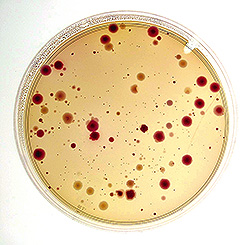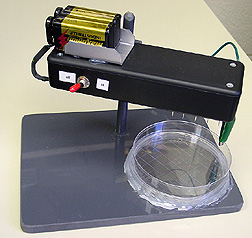Small, Portable Air Sampler Developed
Dust may be a nuisance to a homeowner, but to a poultry grower it can be a disaster. On those dust particles, organisms like Salmonella and E. coli can hitch a ride and wreak havoc in a poultry house or layer room.
A low-cost, simple, portable, electrostatic sampling device was created at the ARS Southeast Poultry Research Laboratory in Athens, Georgia, for high-efficiency sampling of airborne bacteria, viruses, and spores.
The compact, 2-pound device, developed by agricultural engineer Bailey Mitchell and his colleagues, pulls air and dust particles into it for sampling. “The device samples about 212 cubic feet an hour—enough to sample all the air in a small office in about 2 hours,” says Mitchell.
The battery-operated device is housed in a waterproof enclosure, allowing disinfection after use. “It’s completely sealed and self-contained,” says Mitchell, “so it’s easy to clean and disinfect—very important for ensuring accurate sampling.”
The sampler has good potential for detecting microorganisms present in numbers too small to be recovered by traditional methods, such as swab or serum sampling.
“Airborne particles are electrostatically charged by the device, which makes them attracted to grounded surfaces, in this case, a metal plate or an agar dish,” says Mitchell. “It works like two magnets with opposite poles; they’re attracted to one another.”
The electrostatic sampling device has been tested extensively in clean lab areas, in exhaust air from poultry houses, and in caged layer rooms with birds infected with Salmonella enteritidis. It’s shown up to a 20-fold improvement over standard settling-plate sampling techniques and has performed better than a well-known and widely used medium-volume, laboratory-grade, portable impaction sampler costing about 100 times more than Mitchell’s device.
Mitchell says the device can be used in any area where high-efficiency air sampling is needed. Its small size makes it easy to transport and convenient to place in various locations.
“It’s important to know about contamination as soon as possible so it can be dealt with promptly and thoroughly,” he says. Previous devices with good to high-efficiency recovery were typically large and bulky, difficult to disinfect, or expensive—ranging from $1,000 to $25,000. “This unit has about $50 worth of parts, so even if someone pays $200 for it, that is a lot less expensive than the currently available choices.”
Tests suggest the electrostatic device, if operated for 2 hours or more, can sample as much air as a high-volume air sampler and can be operated for about 16 hours with two standard 9-volt batteries. Its low cost and simple operation would make it practical for use in hospitals, too.
“It would dovetail nicely with rapid tests for microbes including Salmonella, Listeria, E. coli, and viruses,” Mitchell says.—By Sharon Durham, Agricultural Research Service Information Staff.
This research is part of Food Safety (Animal and Plant Products), an ARS National Program (#108) described on the World Wide Web at www.nps.ars.usda.gov.
Bailey W. Mitchell is with the USDA-ARS Southeast Poultry Research Laboratory, 934 College Station Rd., Athens, GA 30605; phone (706) 546-3443, fax (706) 546-3161.
"Small, Portable Air Sampler Developed" was published in the October 2005 issue of Agricultural Research magazine.









